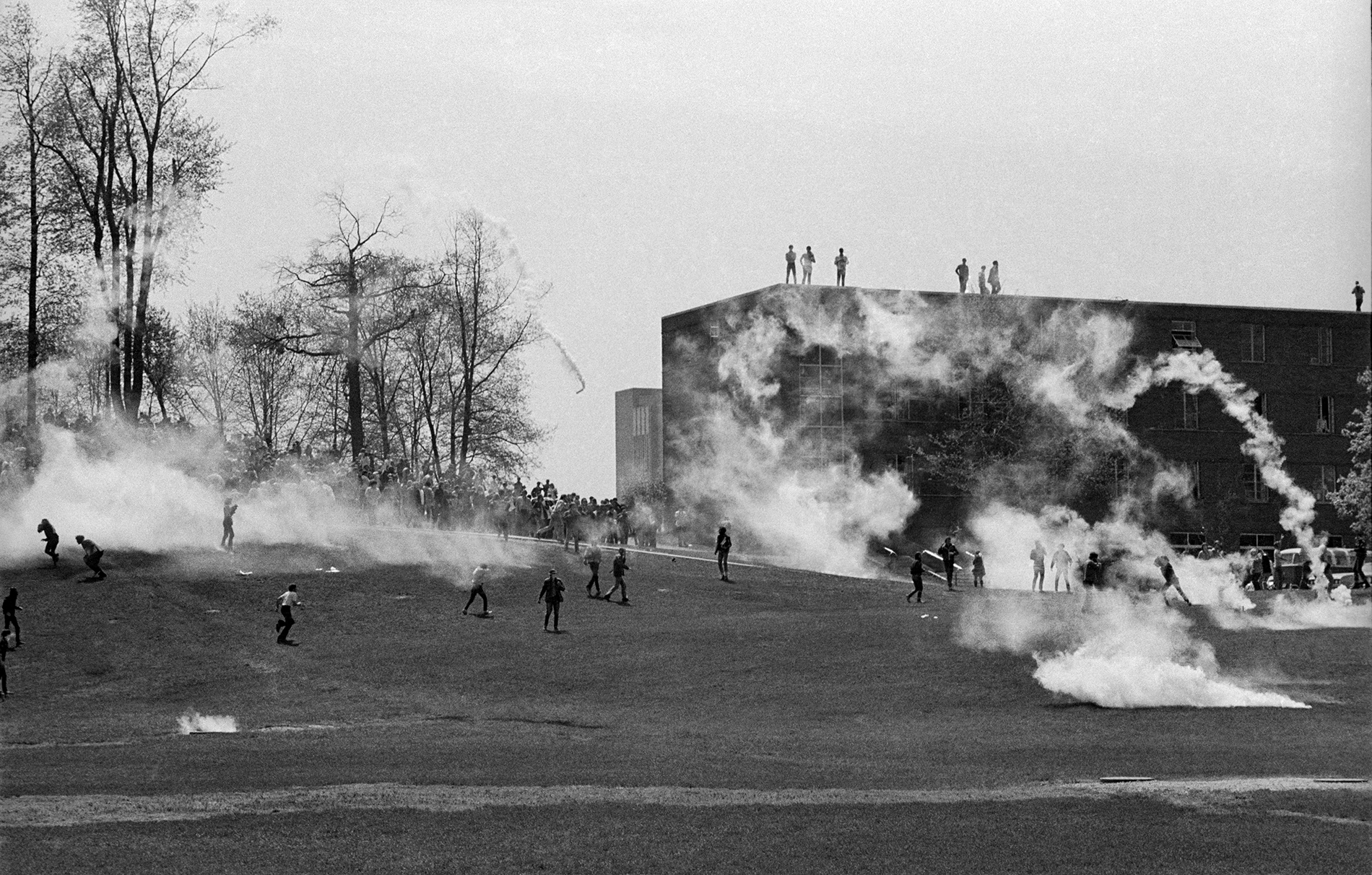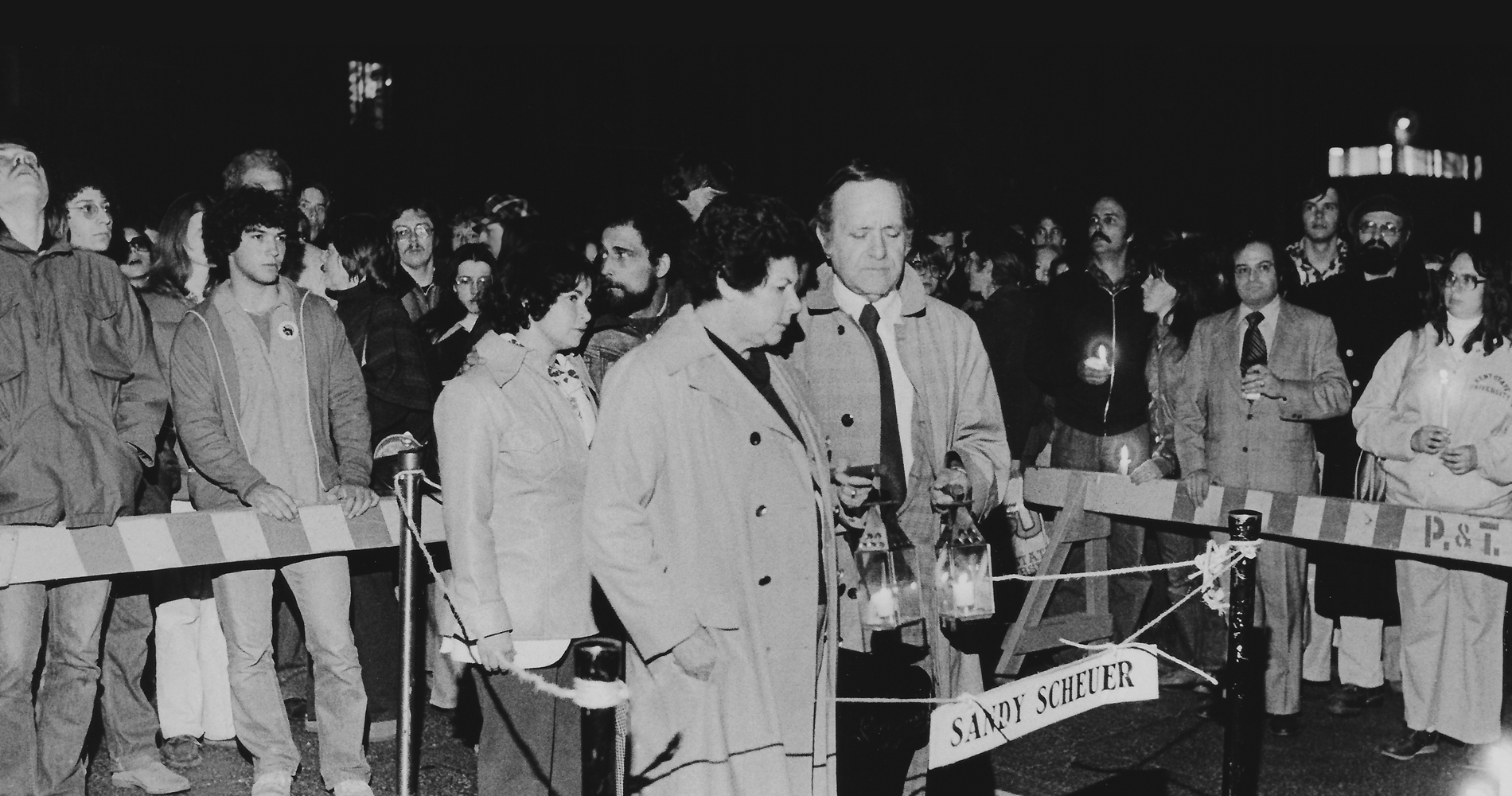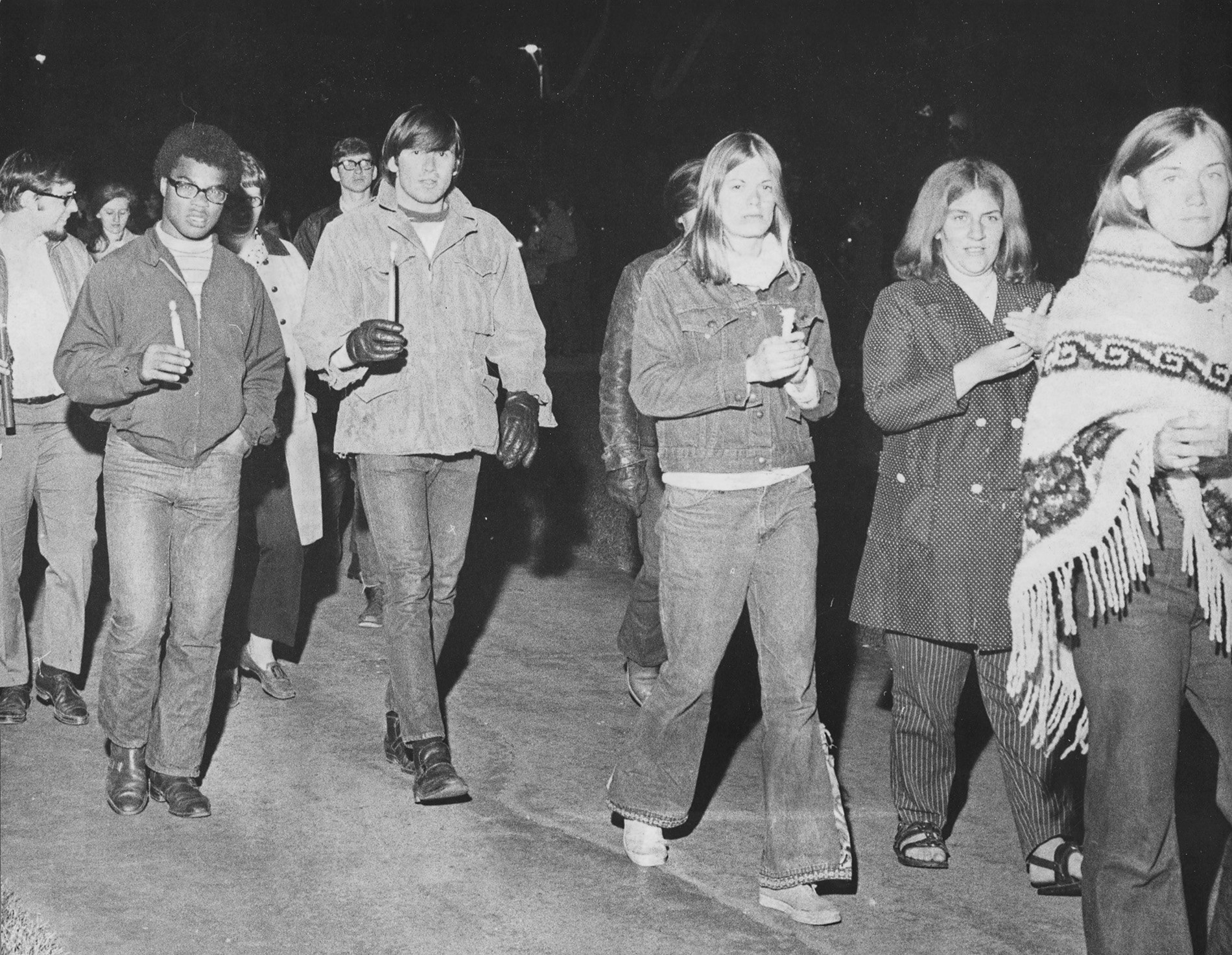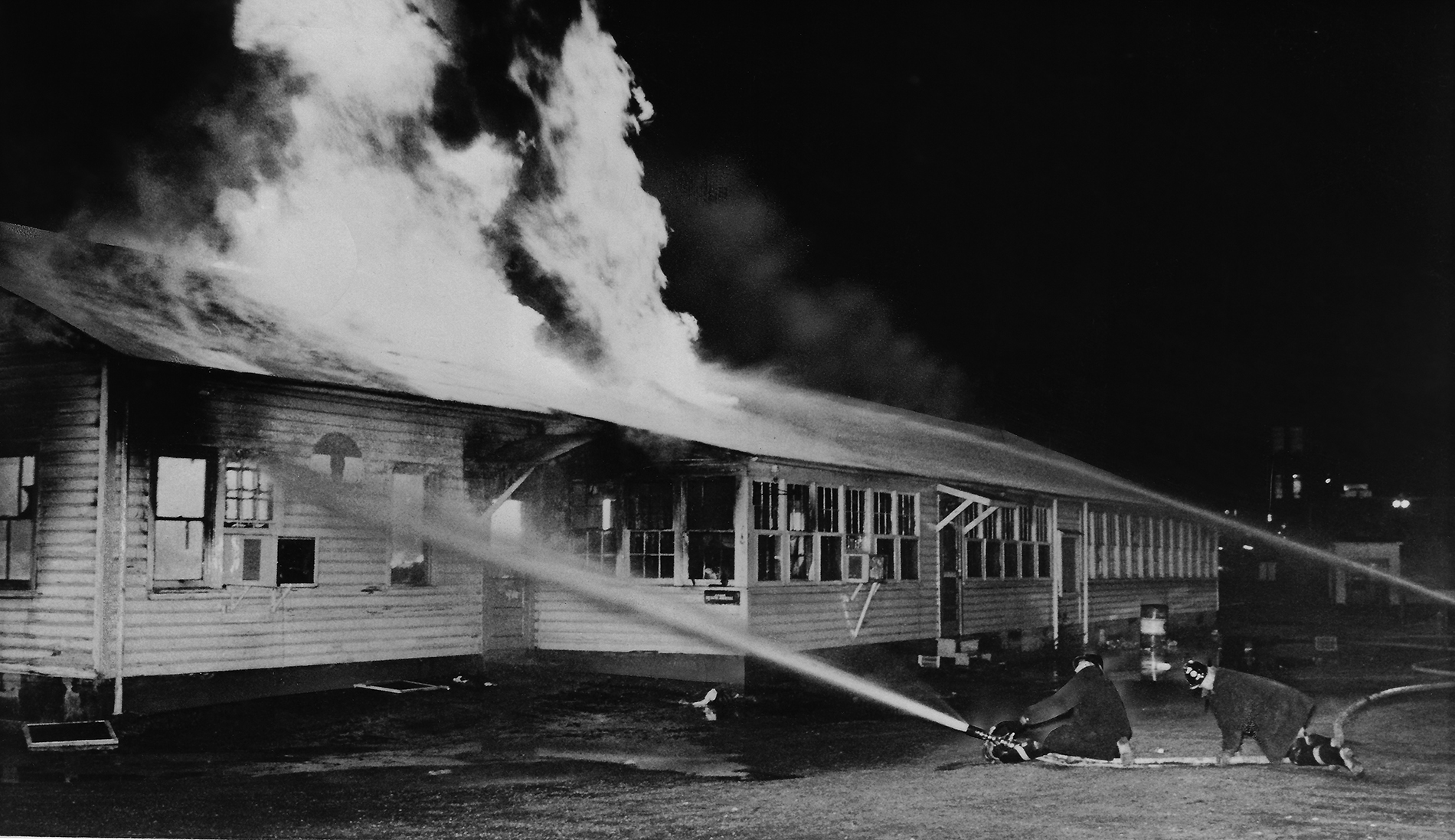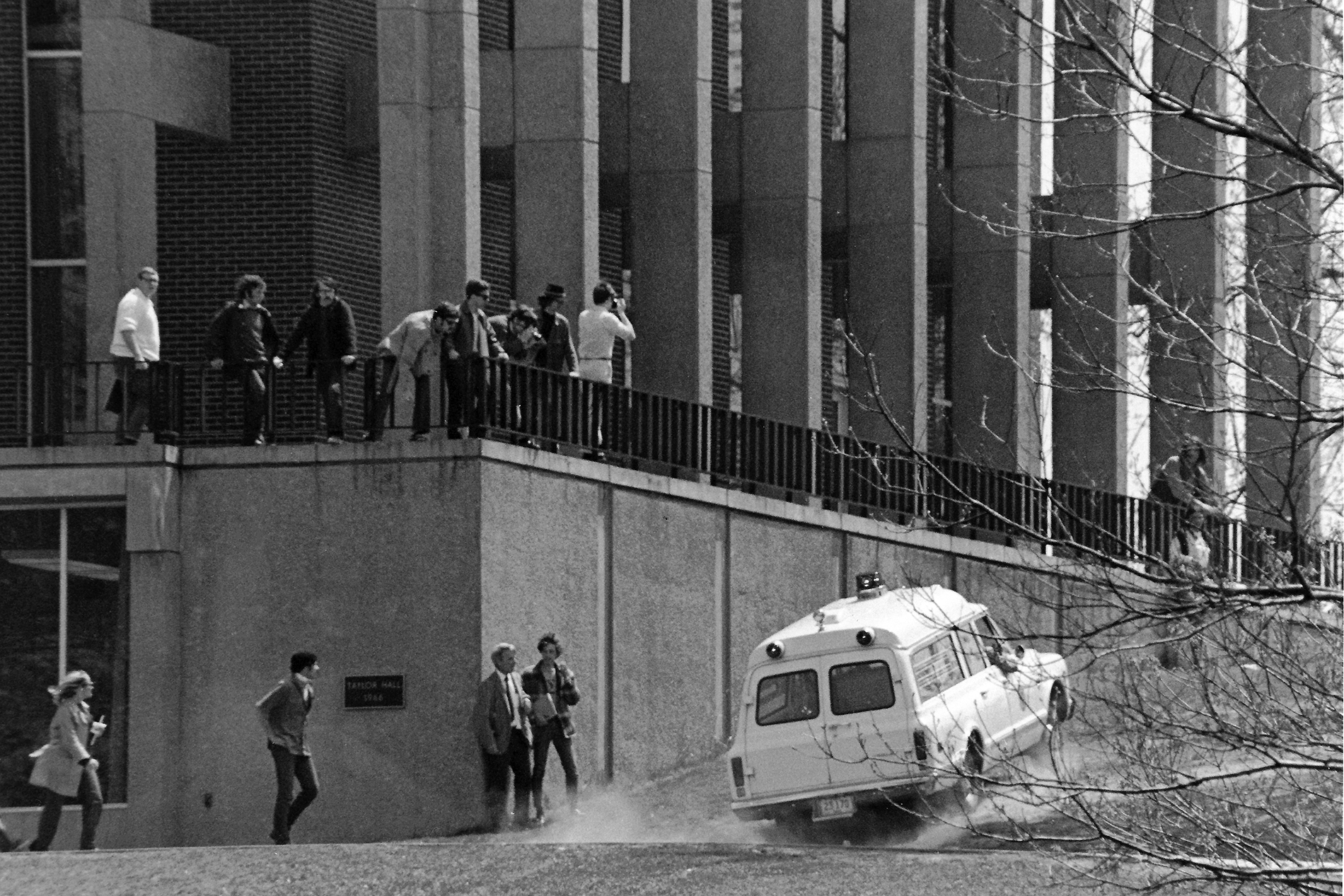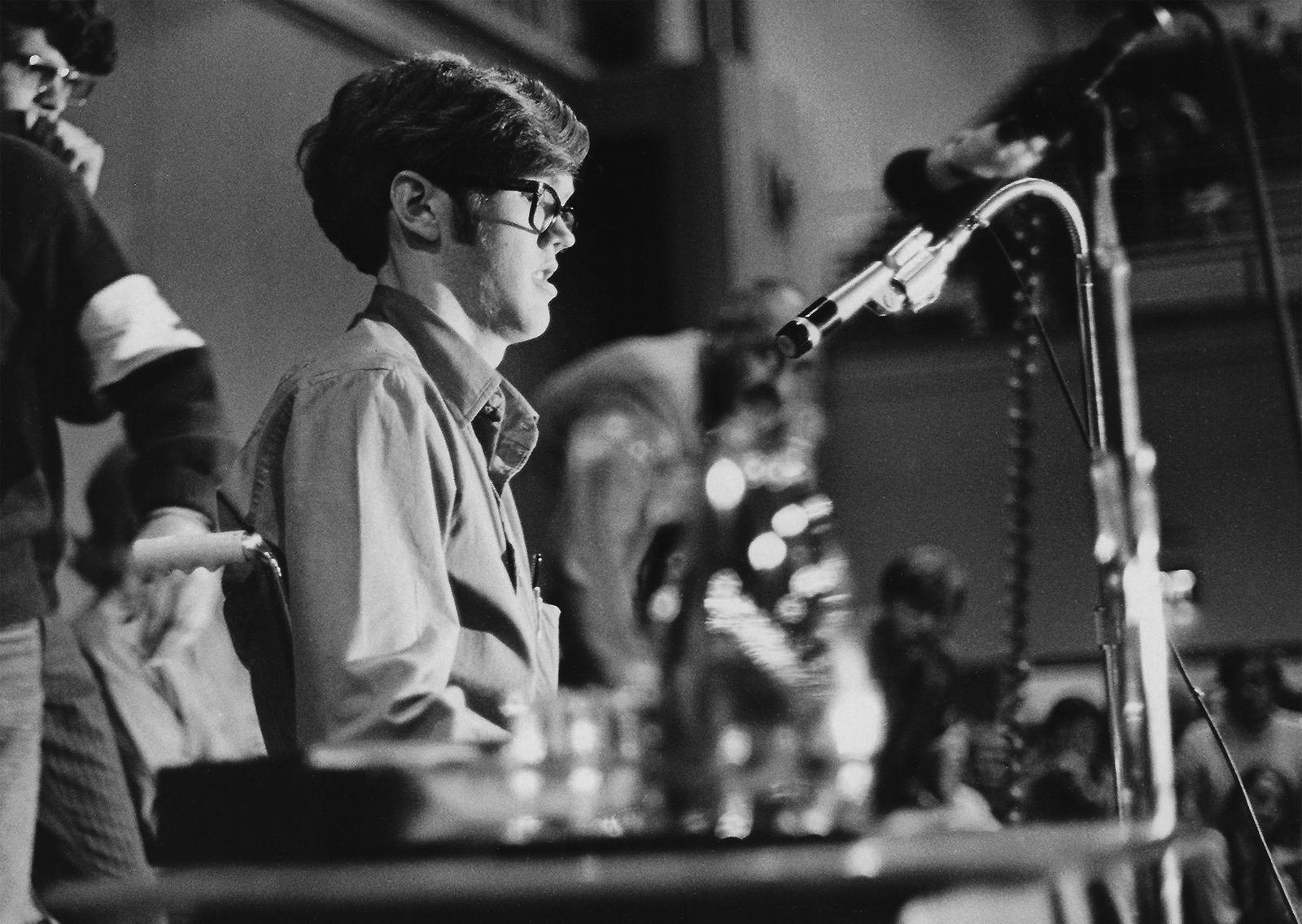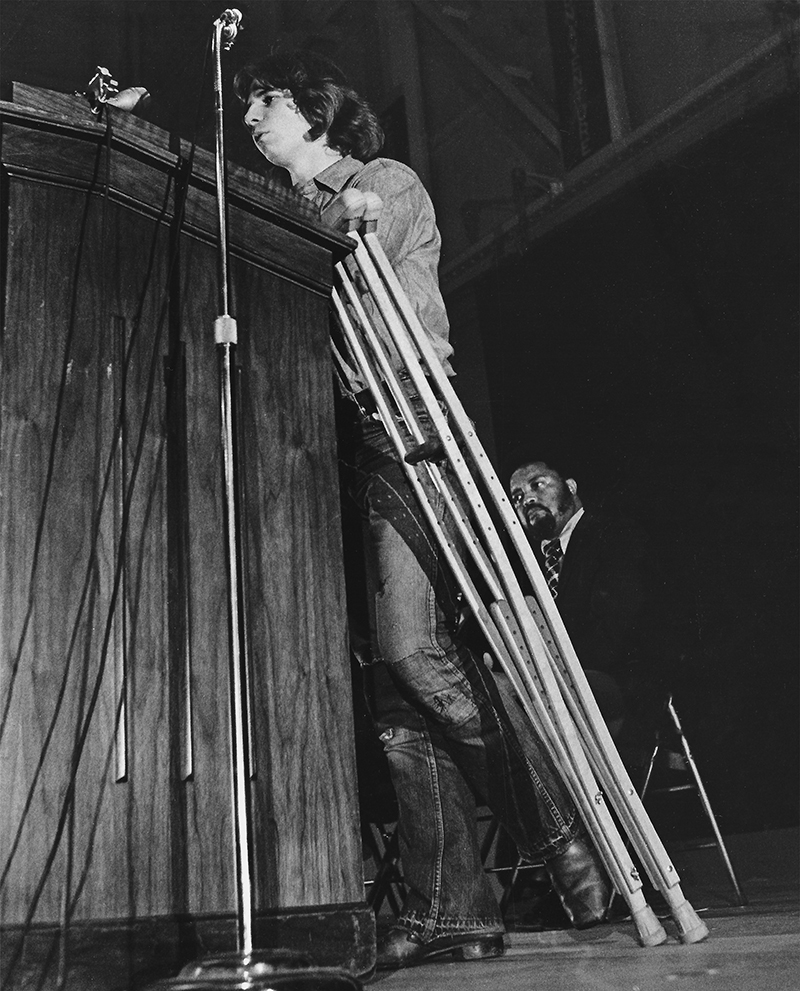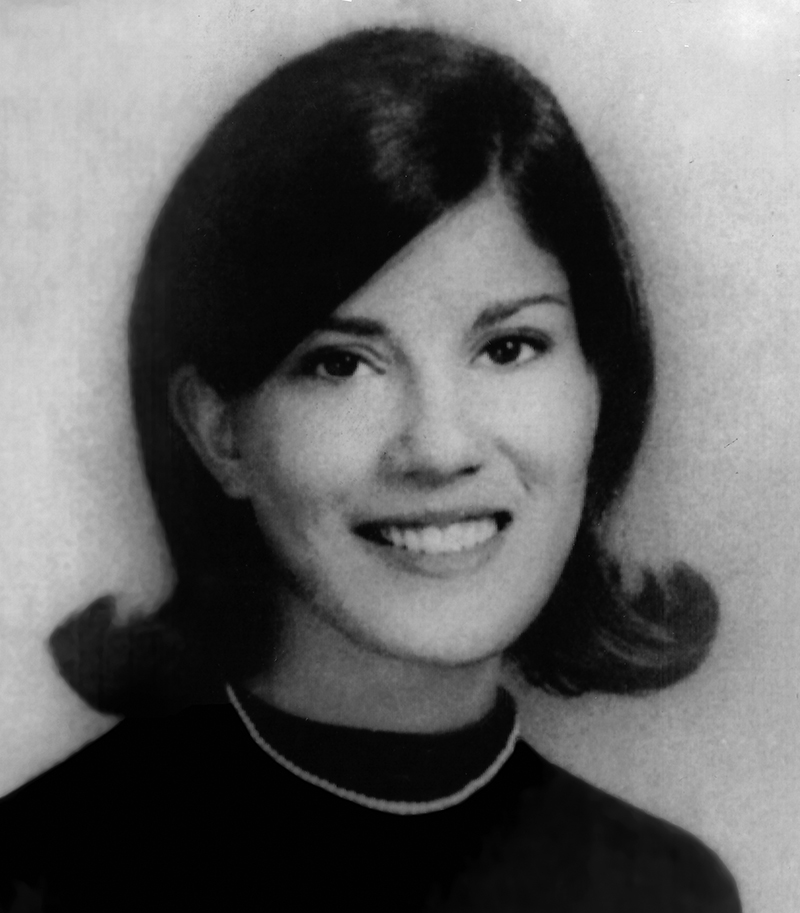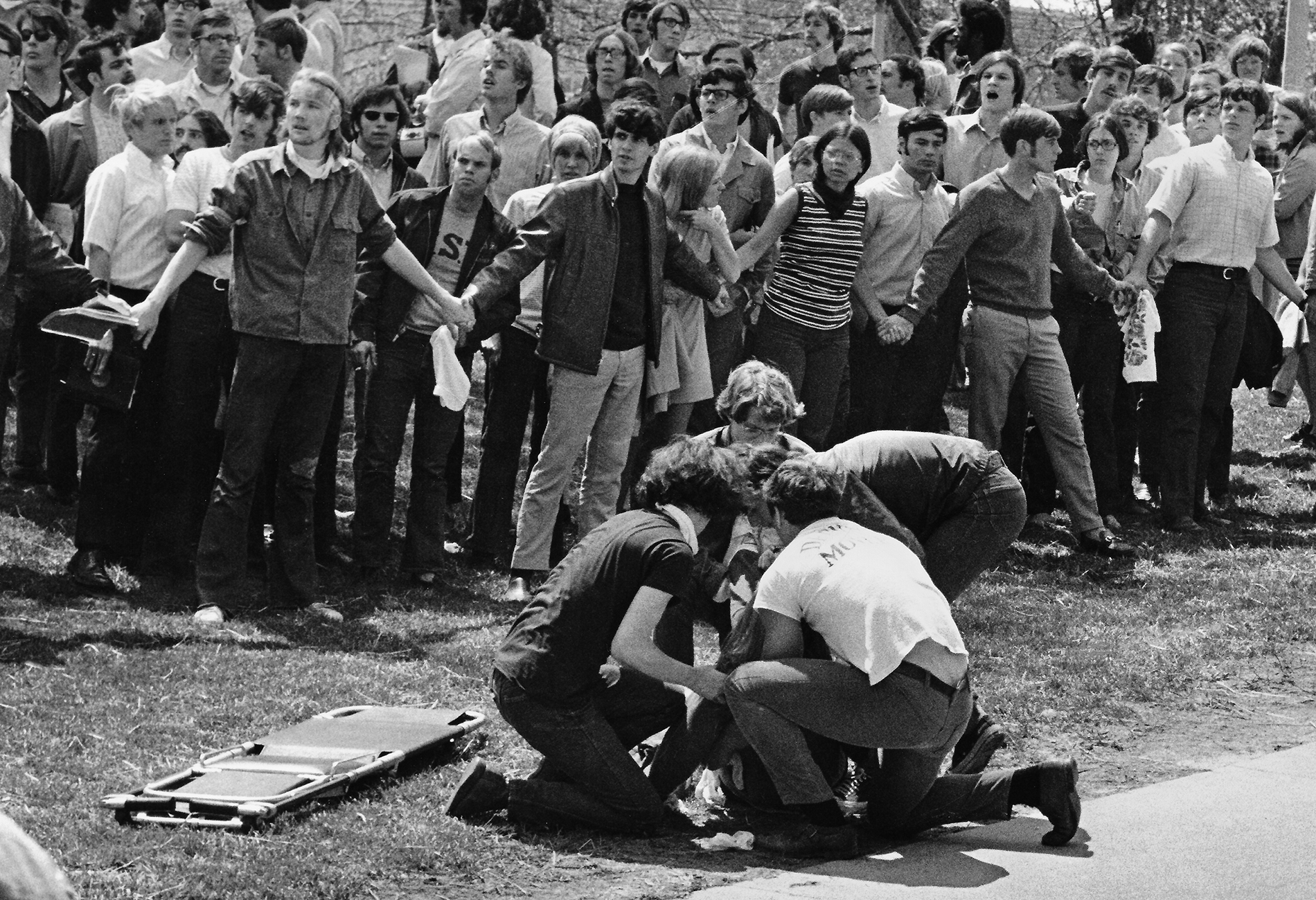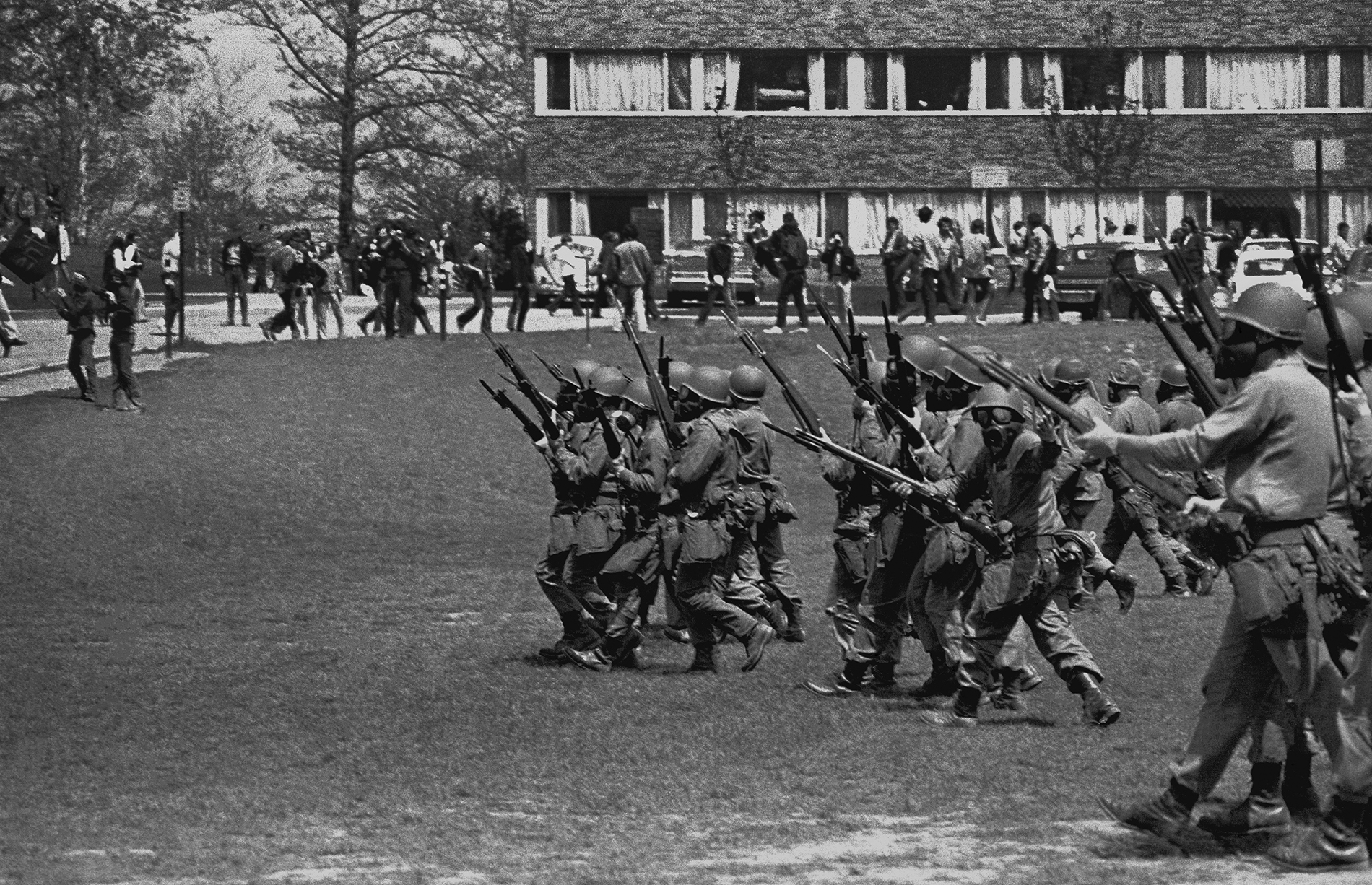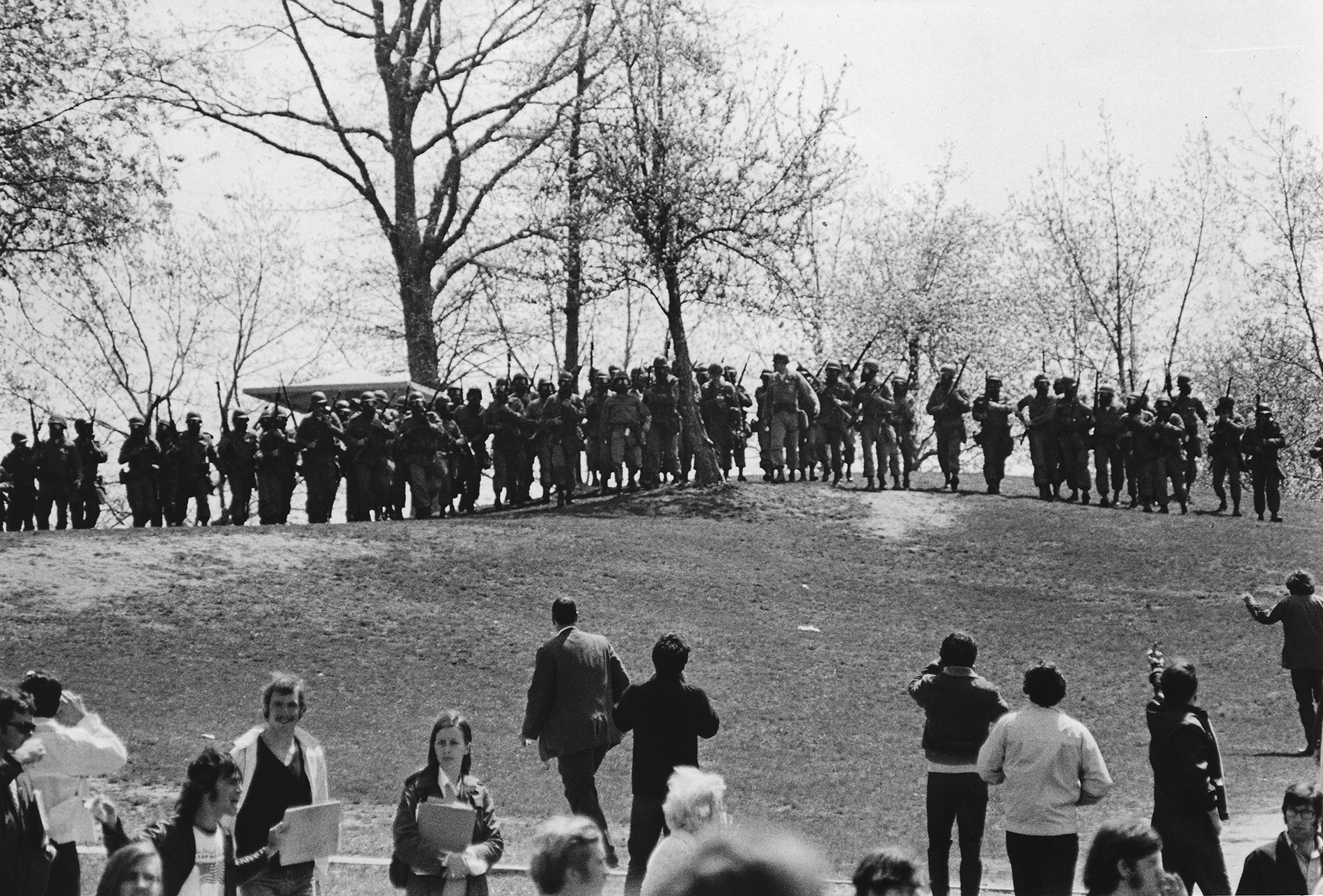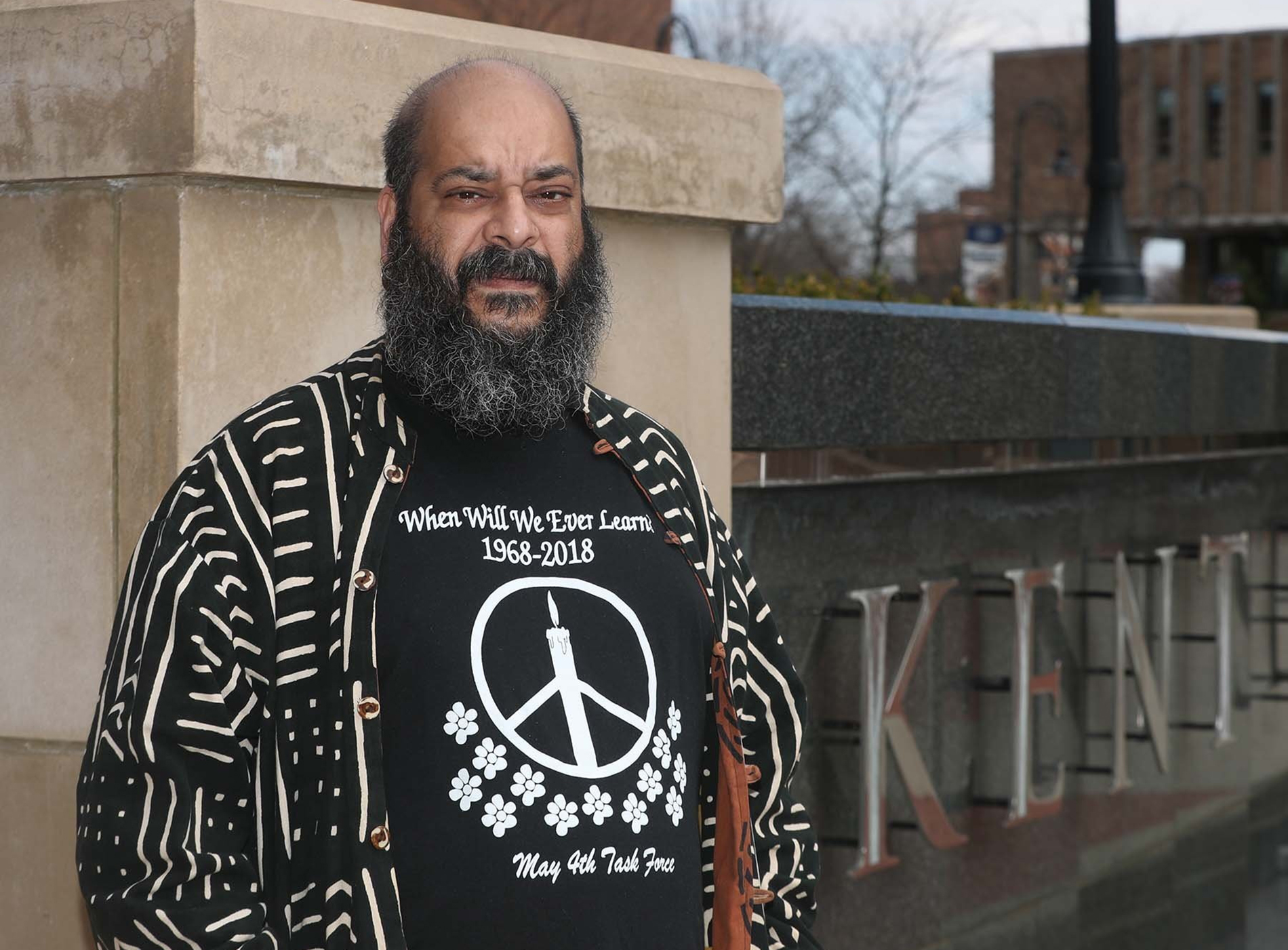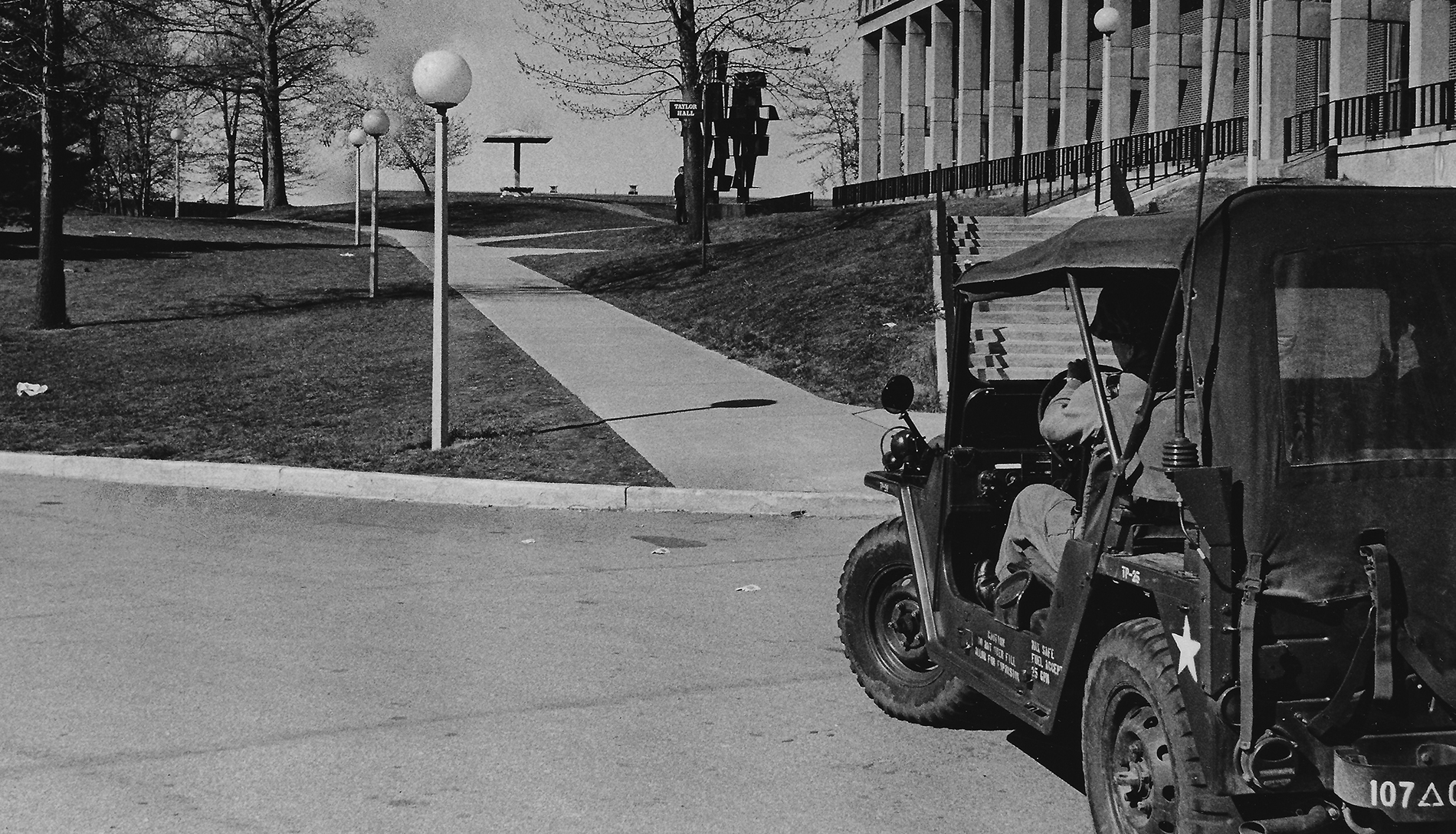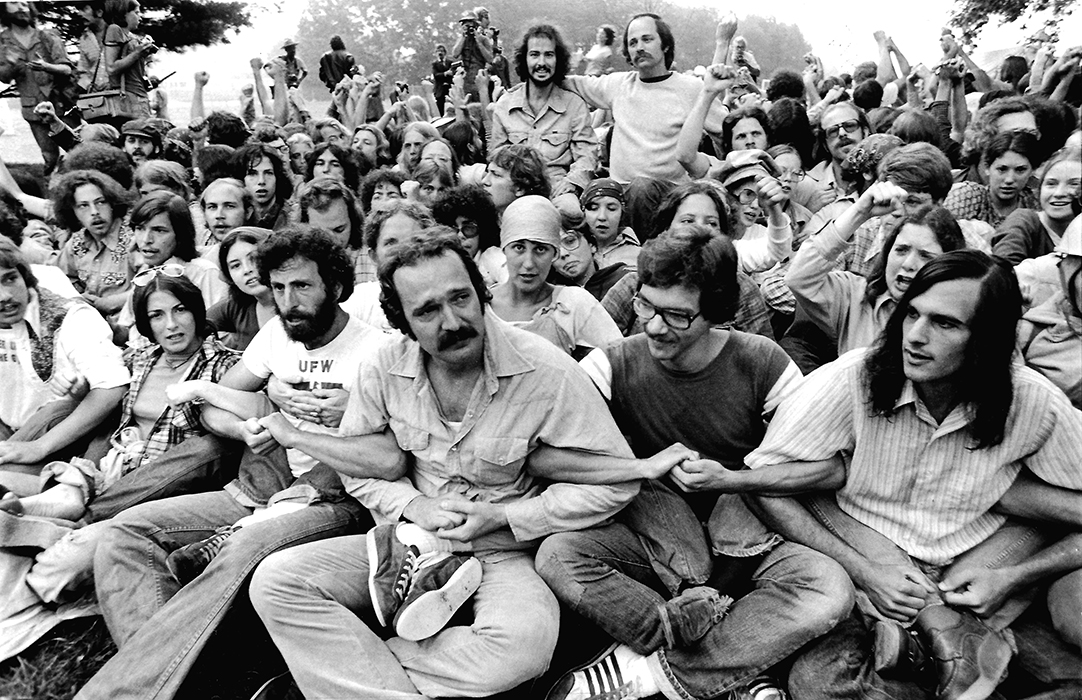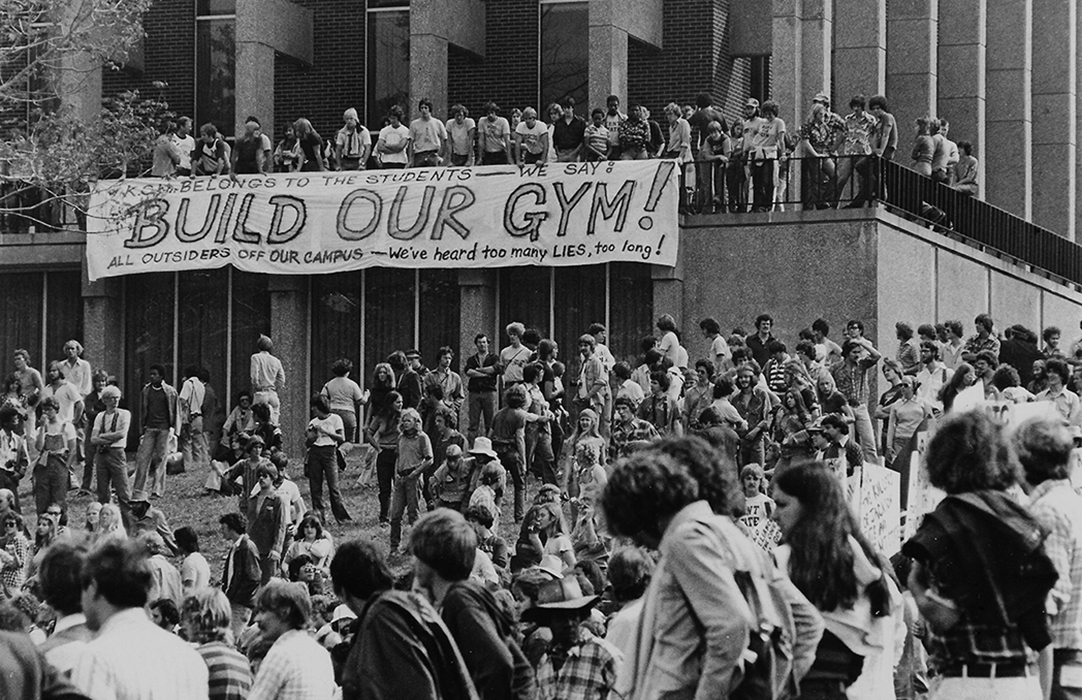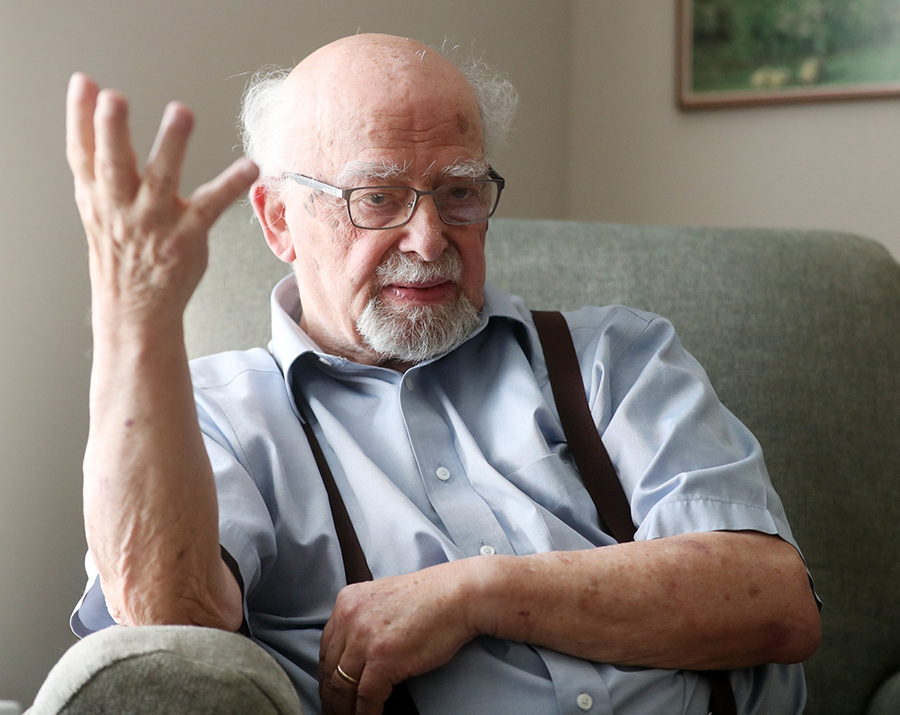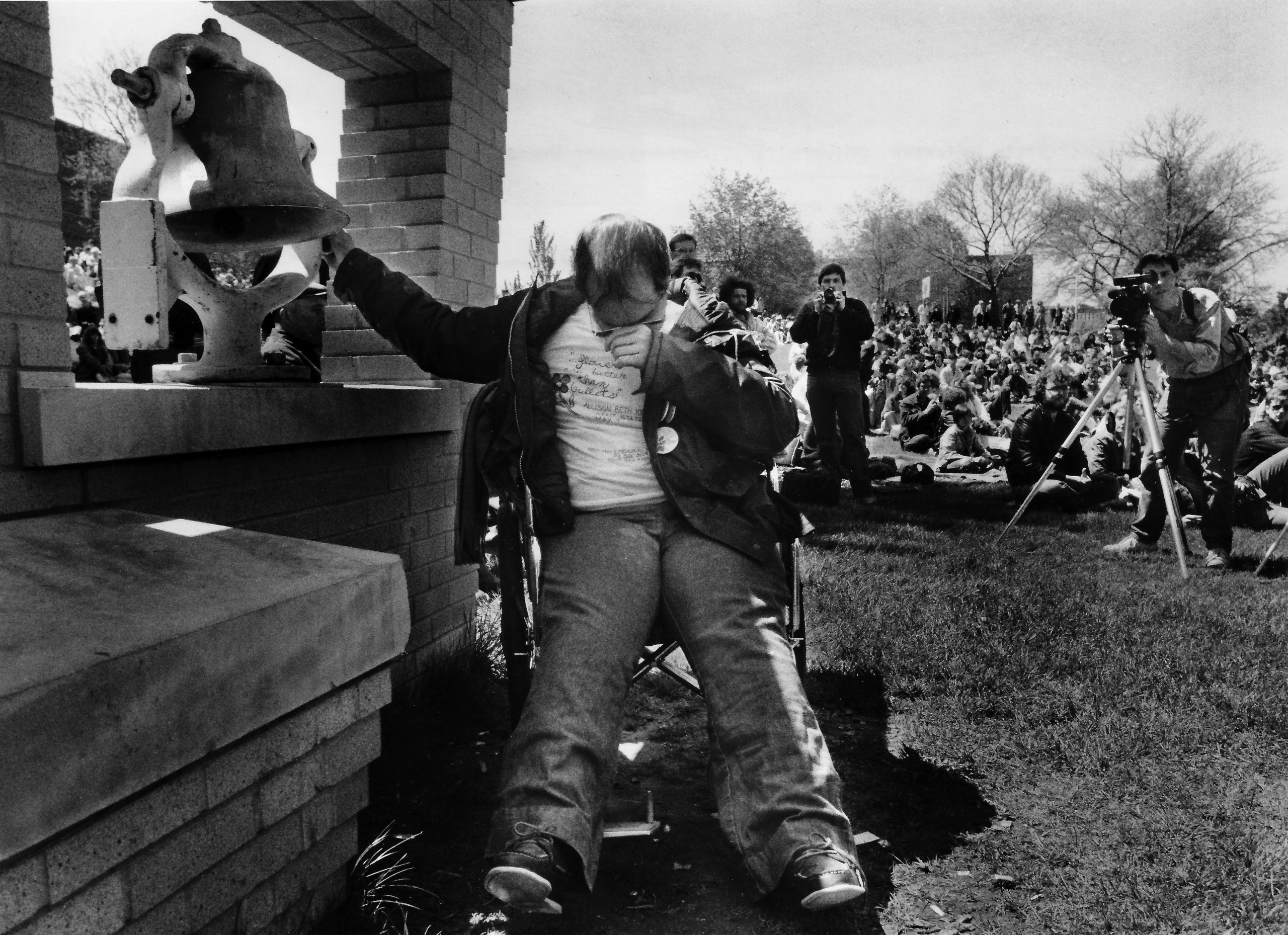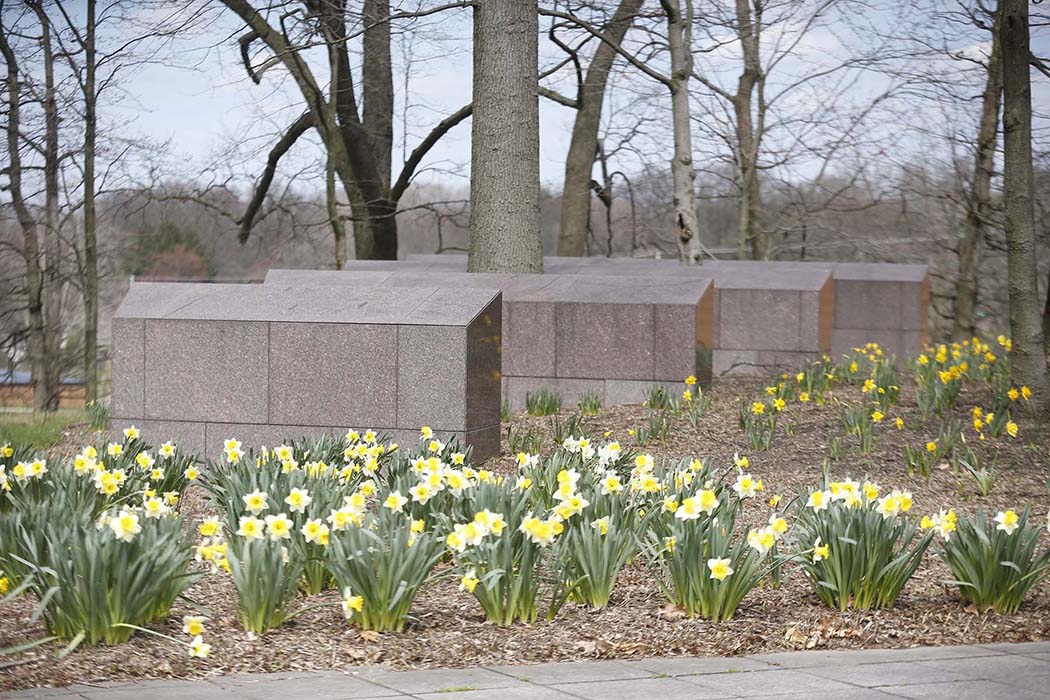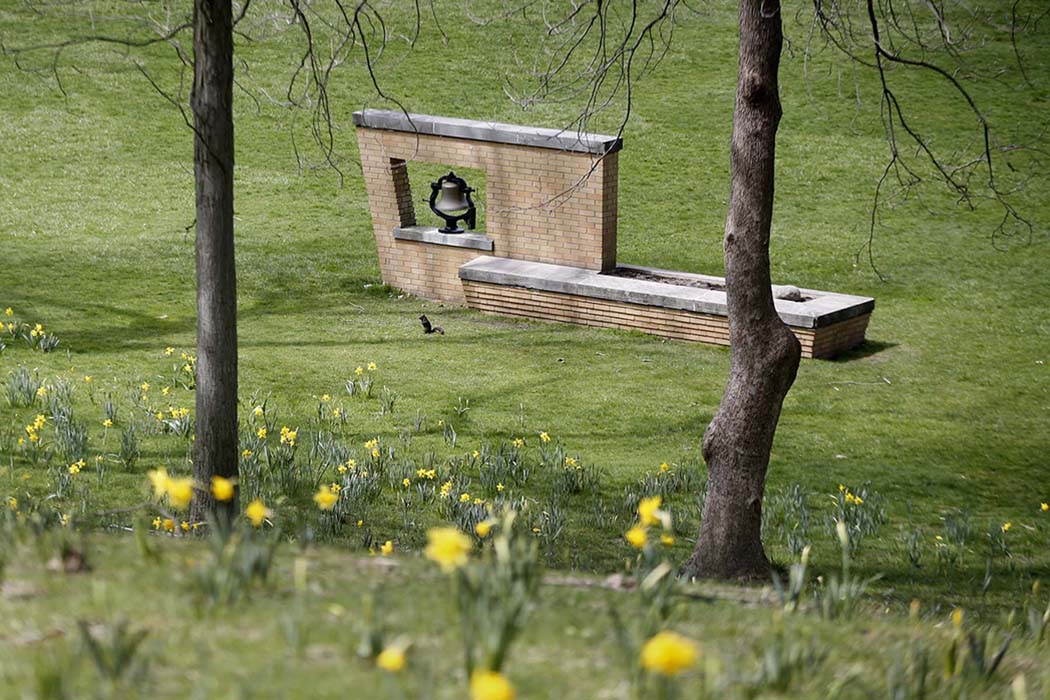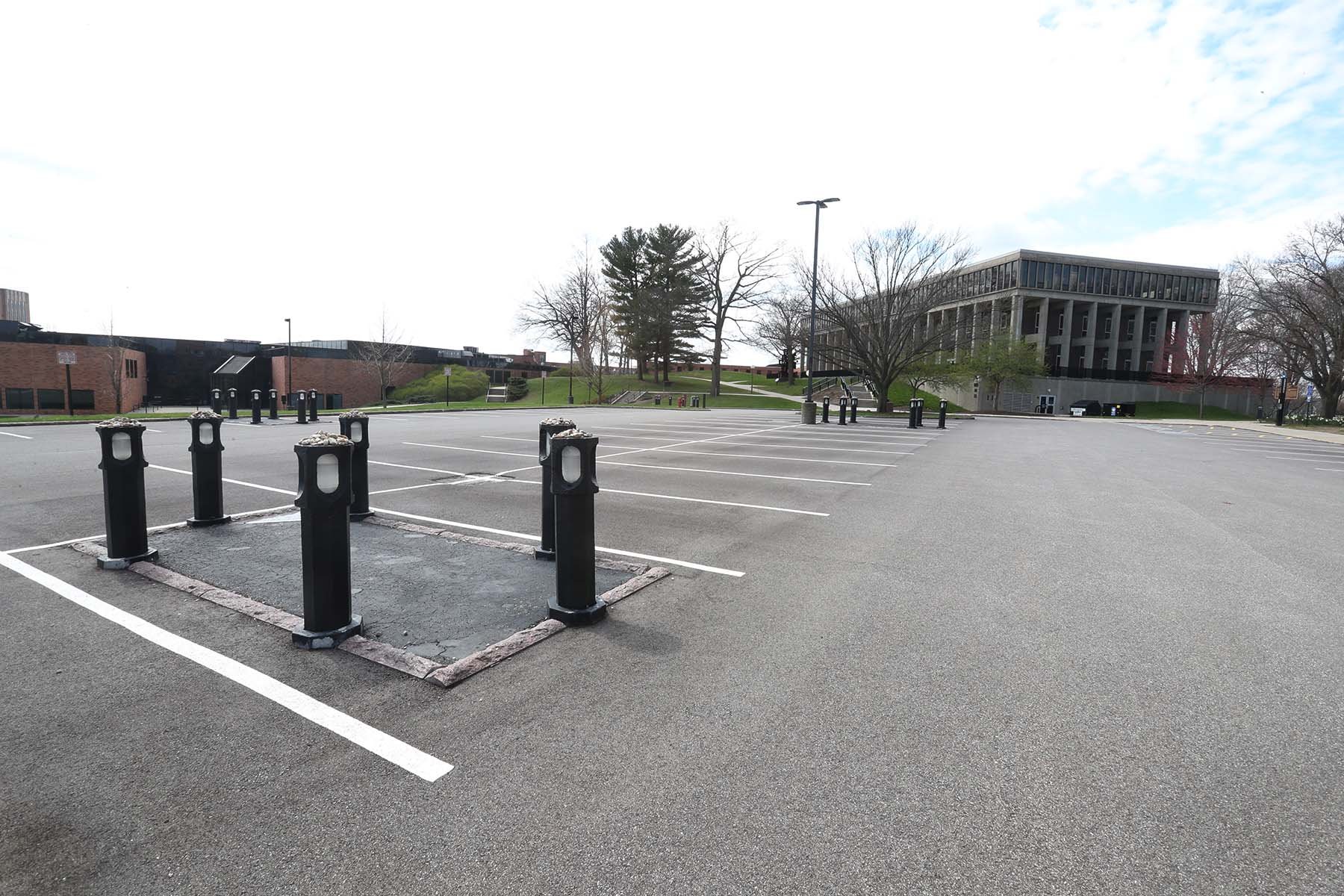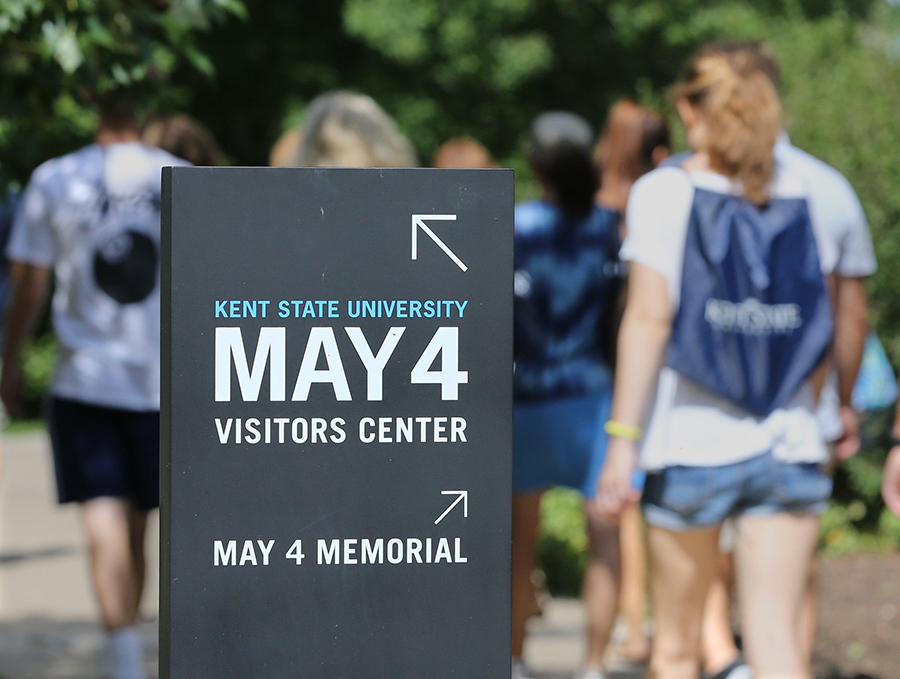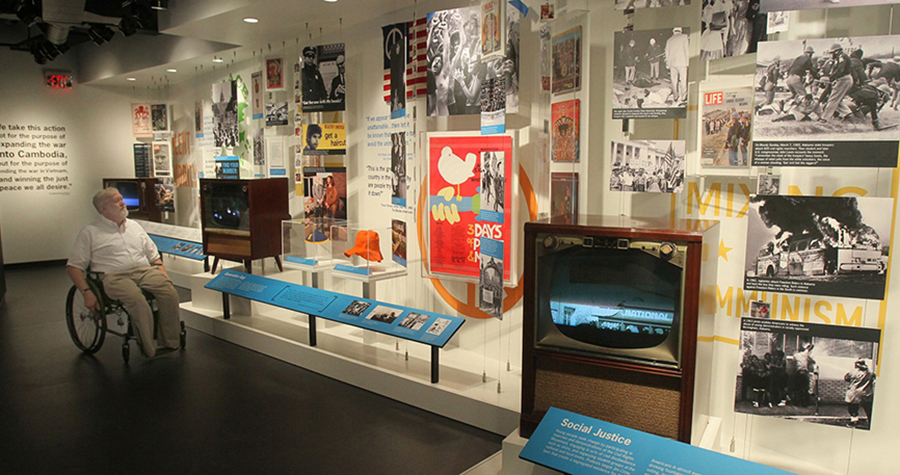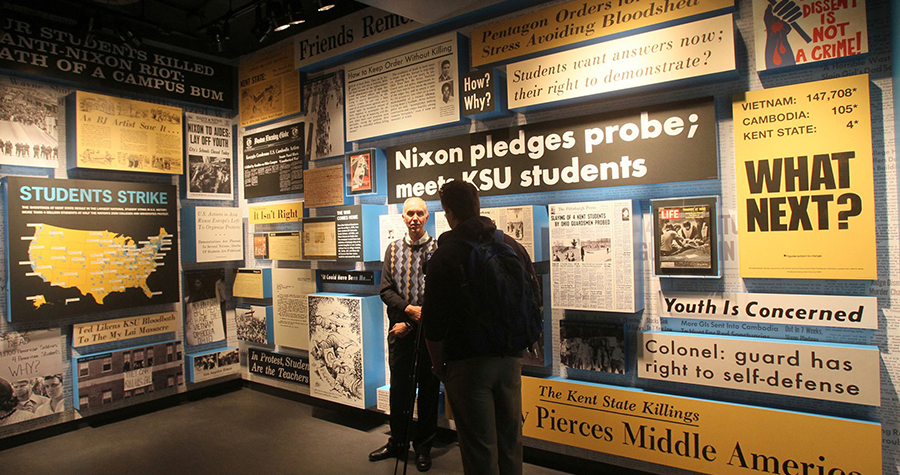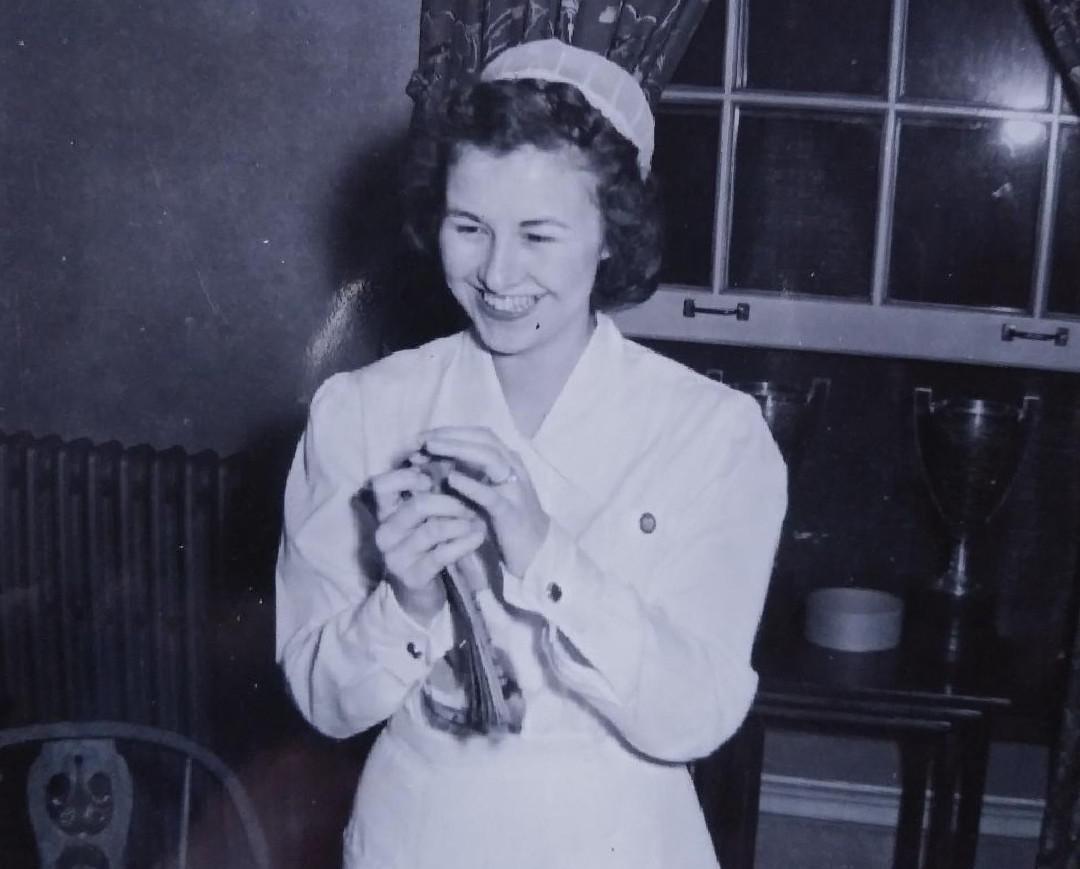Inquire, Learn, Reflect: How Kent State endured the 1970 shootings to embrace its tragic past
By Katie Byard, Akron Beacon Journal and Krista Kano, Record-Courier
April 29, 2020
Jane Fonda was set to make an appearance that had generated controversy, musicians Joe Walsh and David Crosby planned to headline a concert and constitutional law scholar Laurence Tribe was to give a keynote speech.
Thousands of people were expected at Kent State University to commemorate the 50th anniversary of the events of May 4, 1970. That day, Ohio National Guard opened fire on a crowd protesting the expansion of the Vietnam War into Cambodia. Four students – Allison Krause, Jeffrey Miller, Sandra Lee Scheuer and William Schroeder – died. Nine others were wounded.
But the May 1-4 commemoration of the tragedy has been canceled by another — the coronavirus pandemic.
Protesters link arms July 12, 1977, during the Tent City protests at Kent State. An order to disperse was read that morning and 193 people were arrested by unarmed Kent State police officers. Roseanne “Chic” Canfora is at left. Don Roese | Akron Beacon Journal
Supporters of the Gym Annex construction project use a banner hung on the patio of Taylor Hall at Kent State University to let their feelings be known during months of protests over the building in 1977. File photo | Akron Beacon Journal
This year’s anniversary is a milestone not only because it has been half a century since the shootings. It also marks the latest chapter in an evolving story of how Kent State sometimes distanced itself from this defining moment for the university, at other times focused on it and ultimately came to embrace it fully.
“When we look back over the 50 years, we went from being completely at odds with the university” about how to memorialize May 4, said Roseann “Chic” Canfora, but “…we began working together, focusing not on the issues that divided us, but those that united us.”
When we look back over the 50 years, we went from being completely at odds with the university [but] …we began working together, focusing not on the issues that divide us, but those that united us.
Canfora was a sophomore at Kent State in 1970 who ducked behind a car to shield herself when the shooting began. Today, she is a member of the university’s 50th commemoration advisory committee, which includes administrators, faculty, survivors and students.
The group planned dozens of events offered during the academic year. For the first time since 1975, the university had assumed responsibility for May 4 traditions – including the ringing of the Victory Bell at 12:24 p.m., the time of the shootings – that for years had been overseen by the student-run May 4th Task Force.
Year after shootings
The university opened a “living memorial” to May 4 in 1971. It took the form of the Center for Peaceful Change (now the School of Peace and Conflict Studies).
Today, more than 1,000 students enroll in the undergraduate program’s classes each year. It’s one of the biggest such programs in the nation.
“It’s really interesting to see how many people, globally, register May 4,” said R. Neil Cooper, the school’s director. “There is a particular generation internationally who were at the same age as the students when it happened.”
Also in 1971, Jerry M. Lewis, an assistant professor of sociology at Kent State who saw the shootings, organized the first candlelight walk and vigil. It was not until years later that a Kent State president would attend that event.
Jerry Lewis, emeritus professor of sociology at Kent State University, talks about what it was like on campus in 1969 during an interview at his home in Hudson. Mike Cardew | Akron Beacon Journal
At the time of the shootings, Lewis helped to form “faculty marshals,” a group of professors who wore armbands during demonstrations to mark their role as observers and a peaceful presence.
By 1975, university leaders were done with organizing annual May 4 commemorations.
“President Glenn Olds said five years was long enough to remember,” Canfora said.
The student-run May 4th Task Force formed in response.
Canfora’s brother, Alan, was one of the wounded students and among the group’s founding members. Over the years, he has been among the most vocal critics of the administration’s stances on May 4 issues.
“The task force took up the torch,” Chic Canfora said, and each year put together the May 4 commemoration.
Rich Notestine, a graduate of Kent State and a member of the May 4 Task Force, wipes away tears after ringing the Victory Bell during the annual May 4 commemoration ceremonies in 1987. The keynote speaker was Julian Bond. Robin Witek | Akron Beacon Journal
Another low point came in the late 1970s when the university built a gym annex on part of the site of the shootings.
The action “aggravated the injury and stalled the healing,” Richard Bredemeier told the Beacon Journal in 2000. He was near the guardsmen when they fired on the crowd.
The gym annex protest became known as Tent City, with some protesters camping out on the building site for 60 days in 1977. Legal battles went to the Supreme Court. The Memorial Gym Annex opened in 1979.
A memorial
In 1990 the May 4 Memorial – a stone plaza dominated by granite walls – was dedicated after many years of discussion.
Critics deemed it as inadequate, some calling it a “mini memorial.”
The university couldn’t meet the proposed $1.3 million cost. A scaled-down version was built for less than $200,000.
A portion of the May 4th Memorial dedicated at Kent State University in 1990. Karen Schiely | Akron Beacon Journal
Kent State’s victory bell remains a focal point on the campus Commons just as it was during the 1970s protests. Karen Schiely | Akron Beacon Journal
The engraved words “Inquire, Learn, Reflect” – on stone where visitors step into the space – did not memorialize the victims, critics said. The names of the slain students and an explanation of what happened on May 4, 1970, were not part of the memorial.
Shortly before the May 4, 1990, memorial dedication, a plaque — engraved with the names of the killed and wounded — was placed near the sidewalk north of the memorial.
Professor Lewis praises former President Michael Schwartz for “getting the memorial going” in the 1980s.
“I think it’s important when you prepare to go into it,” Lewis said, “and you look down, and there are those three words, “inquire, learn and reflect’… it’s like a professor talking to a student.”
Opening up
In July 1998, President Carol Cartwright agreed to a May 4th Task Force request to close off the area in the parking lot where the four students were killed. Memorials were installed.
“Coming off all those years where they [university leaders] just wanted us to go away,” Canfora said, ”President Cartwright heard us about the families’ desire to cordon off the sacred spots where their children died.”
Cartwright was the first president to attend the candlelight march and vigil.
An empty parking lot except for the four memorials for the students killed during the May 4, 1970 shootings on the campus of Kent State University Saturday, April 11, 2020 in Kent, Ohio. Karen Schiely | Akron Beacon Journal
Cartwright said recently that a 1998 report by the university’s Centennial Commission recommended that Kent State “recognize and promote the unique history of May 4, 1970, and how that created change at Kent State University and in American society.”
Under President Lester Lefton, Kent State opened the May 4 Visitors Center in 2012 in Taylor Hall, near where the shootings occurred. The Center includes a gallery display about the Vietnam War and a timeline of May 4, 1970, and related events.
Laura Davis, co-creator of the Center and May 4 Walking Tour, said the idea was to embed the story of May 4 within the site of the shootings so it would not be forgotten. Carole Ann Barbato worked with Davis on the project.
There were so many people who would come [to the site of the shootings] either as visitors or just driving by on the freeway… and come and wander because nothing was marked
“There were so many people who would come [to the site of the shootings] either as visitors or just driving by on the freeway… and come and wander because nothing was marked,” said Davis, an emeritus professor and a member of the 50th commemoration advisory committee. “It was our intention to tell the story as completely as possible within the site so that it wouldn’t get lost.”
Early in his presidency, Lefton took two tours of the parts of campus that were tied to May 4, 1970.
“It was like a light bulb went on and he said, `Now I see it,’ ” Davis recalled.
In 2010, the 17-plus acre May 4 site was named to the National Register of Historic Places. In late 2016, as the 50th anniversary was approaching, the site reached National Historic Landmark status.
A tour group walks past a sign that points out directions to the May 4 Visitors Center and Memorial near Taylor Hall on Friday, Aug. 18, 2017 in Kent, Ohio. Phil Masturzo | Akron Beacon Journal
Christopher Post, a geography professor at Kent State who studies how places commemorate events, said finally the university was piecing together a memorial landscape that “produced a message of what happened here… that people should have had the right to protest.”
With physical memorials, “we’re trying to produce a sense of empathy for those who have been negatively impacted by the tragedy,” Post said.
Effective memorials, he said, should allow people to “understand the root cause of the tragedy, whether it’s terrorism or a shooting, or labor or racial injustice or the practice of free speech in a public place.”
Post noted that new markers signifying the spots where the nine wounded students were shot were to be dedicated May 4.
Controversy
The 50th commemoration plans have not been without controversy.
Jane Fonda’s scheduled appearance elicited strong reactions in favor and against the actress and activist.
Those opposed to Fonda said she served as a propaganda tool for the North Vietnamese when she went to Hanoi in 1972 and posed for a photograph with a North Vietnamese anti-aircraft gun.
The commemoration committee responded by saying in a February statement that it takes “to heart the painful feelings” expressed by Fonda’s opponents. “We are equally moved by those who expressed their high regard for Fonda’s atonement… and her lifeline activism in support of human rights and civil rights.”
Lessons learned
In a speech at the Chautauqua Institution in the summer of 2018, President Beverly Warren said: “Kent State has progressed from trying to forget the shootings to owning that horrific moment — and honoring the whole spectrum of emotions they inspire.”
Kent State has progressed from trying to forget the shootings to owning that horrific moment — and honoring the whole spectrum of emotions they inspire.
Warren spoke of the institution as a “wounded healer,” referring to the Persian poet Rumi, who wrote, “The wound is the place where the light enters you.”
She said Kent State will use the “lessons of 50 years to convene people, heal conflict and create a more inclusive, more people peaceful future.”
Warren’s speech, Canfora said, “acknowledged the role the university should play in public discourse and should have played in the protection of our freedom of speech on college campuses” in 1970.
Dean Kahler, who was paralyzed when he was shot in the May 4 shootings, looks at an exhibit in the new May 4 Visitors Center in Taylor Hall at Kent State University in 2012. Michael Chritton | Akron Beacon Journal
Journalist Matt Fredmonsky interviews retired KSU professor Mark Seeman in the new May 4 Visitors Center in Taylor Hall at Kent State University in 2012 in Kent, Ohio. Seeman spearheaded the campaign to have the site of the shootings added to the National Register of Historic Places. Michael Chritton | Akron Beacon Journal
That speech led Canfora and others to write a letter to Warren suggesting that Kent State provide the resources in perpetuity for an annual commemoration. The letter was signed by family members of the slain students, as well as the seven living wounded survivors.
Trustees in March of 2019 approved a resolution to that effect, in time for the 50th anniversary. The resolution also says Kent State will ensure ongoing education regarding the event that shocked the nation.
Katie Byard can be reached at kbyard@thebeaconjournal.com. Krista S. Kano can be reached at kkano@recordpub.com or 330-541-9416.
